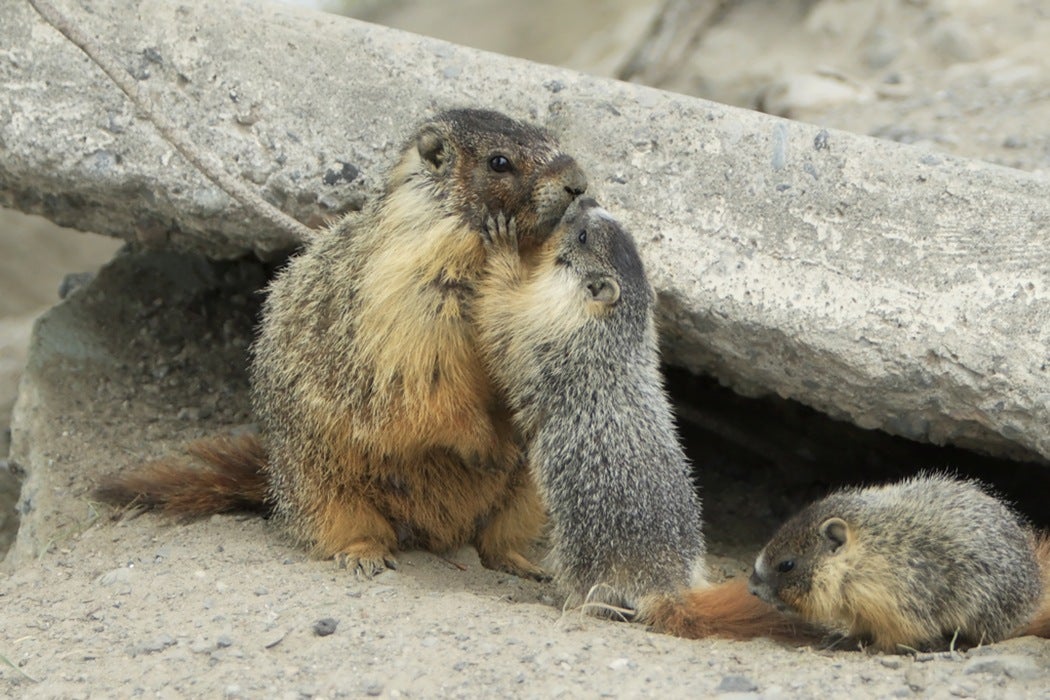A common vampire bat, Desmodus rotundus, returns from a successful night of feeding. She snuck up on a sleeping cow, consuming enough of its blood to increase her body weight by 50%. Upon arriving at the tree she shares with a group of other female bats, she finds that one of the other bats in her roost hasn’t been so lucky. For the second night in a row, this other female has failed to feed, and she is close to starving to death. The returning bat sidles over to her and offers her a regurgitated mouthful of her own hard-earned blood meal. Both of them will live to bite another day.
When individuals behave altruistically, they act to benefit another individual of their species at some cost to themselves. From an evolutionary point of view, this behavior is hard to understand. An animal that maximizes its own health should be stronger and more able to pass along its genetic material than an animal that makes sacrifices for others. By that logic, natural selection should weed out the do-gooders and leave only egoists. Nevertheless, altruistic behavior exists—not only in humans, but in social species ranging from monkeys to bluejays. Just as female vampire bats share meals with other bats in their group, marmots delay their own reproduction to help their group-mates raise young. Sharing seems to be an essential part of social living in many species.
Darwin himself considered altruism to be a snag in his evolutionary theory. He was especially concerned by honeybees: an example of the most extreme form of altruism, eusociality, in which some individuals completely forego reproduction to care for the offspring of others. Darwin found it difficult to explain why a system like natural selection, which would reward individuals for reproducing, would create individuals that did not reproduce.
It took nearly a century for another biologist, W.H. Hamilton, to come up with a plausible explanation. A natural scientist studying economics, Hamilton visualized sharing in terms of costs and benefits. He theorized that sharing wasn’t just about the sharer, but also about the recipient. According to his equation, now known as Hamilton’s Rule, individuals are more likely to behave altruistically the more closely related they are genetically. Hamilton’s rule predicts that individuals that share 100% of their genetic material will always share as long as the benefit to the recipient outweighs the cost to the giver. If two individuals are 50% related, the benefit to the recipient has to be a lot greater—twice as big as the cost—for sharing to occur. Unrelated individuals, who have no genetic material in common, will never share with one another. Hamilton’s theory provided the basis for kin selection, an idea embraced by popular scientists like Richard Dawkins as an explanation for the puzzling existence of generosity.
In the real world, however, kin selection isn’t quite so clear, and individuals often defy Hamilton’s predictions by sharing with both relatives and non-relatives. Recent models of individual behavior have proven that, although altruism develops more easily in groups of related individuals, genetic relationships aren’t necessary. In fact, the most important factor in altruistic societies was a social environment that rewarded sharers and punished cheaters. Vampire bats, for instance, were more likely to share meals with bats from whom they had received meals in the past. Likewise, honeybees exert strong social pressure on one another to avoid reproducing. When workers go rogue and try to produce their own young, other workers quickly destroy the eggs. A society that excludes selfish individuals can prevent selfish genes from invading the population, which may mean greater chances of survival for the species. Ultimately, evolution provides a kind of positive feedback between altruism and behaviors that protect altruism, and the original reason for altruism—genetic relationships—eventually becomes unnecessary.
Altruism in animals provides an interesting perspective on how “social virtues (courage and self-sacrifice),” to quote Hamilton, might have evolved in human societies. The study of altruism borrows heavily from human economic theories, like the Prisoner’s Dilemma, to explain how cheaters might invade or be excluded from animal societies. Perhaps learning about the mechanisms that create and maintain generosity in other species might help us to promote it in our own. Even if it doesn’t provide a blueprint for human utopia, I sometimes find myself considering the sweetly-gory blood sharing of the vampire bat as a kind of moral example. If something as small as a bat is able to recognize when its neighbors are in trouble and act to help them survive, then maybe we can do a little bit better too.







